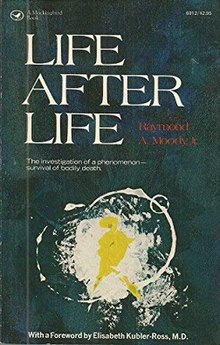 First edition | |
| Author | Raymond A. Moody |
|---|---|
| Publisher | Mockingbird Books |
Publication date | 1975 |
| Media type | |
| Pages | 175 |
| ISBN | 978-0-89176-037-5 |
| OCLC | 12173853 |
Life After Life is a 1975 book written by psychiatrist Raymond Moody. It is a report on a qualitative study in which Moody interviewed 150 people who had undergone near-death experiences (NDEs). The book presents the author's composite account of what it is like to die, supplemented with individual accounts.[1][2] On the basis of his collection of cases, Moody identified a common set of elements in NDEs:[3]
- (a) an overwhelming feeling of peace and well-being, including freedom from pain.
- (b) the impression of being located outside one's physical body.
- (c) floating or drifting through darkness, sometimes described as a tunnel.
- (d) becoming aware of a golden light.
- (e) encountering and perhaps communicating with a "being of light".
- (f) having a rapid succession of visual images of one's past.
- (g) experiencing another world of much beauty.[3]
Life After Life sold more than 13 million copies,[4] was translated into a dozen foreign languages[5] and became an international best seller, which made the subject of NDEs popular and opened the way for many other studies.[6][7]
- ^ Clifton D. Bryant (2003). Handbook of Death and Dying Sage, p.138.
- ^ Michael Marsh. Review: Beyond Death: The Rebirth of Immortality The Hastings Center Report, Vol. 7, No. 5 (Oct., 1977), pp. 40–42.
- ^ a b Harvey J. Irwin and Caroline Watt. An introduction to parapsychology McFarland, 2007, p. 159.
- ^ Towards the light The Age, March 23, 2004.
- ^ Louis E. LaGrand (1999), Messages and miracles: extraordinary experiences of the bereaved, St. Paul, MN: Llewellyn Worldwide, p. 9, ISBN 1-56718-406-5
- ^ Harvey J. Irwin, Caroline Watt (2007). An introduction to parapsychology McFarland, p. 158.
- ^ Duane S. Crowther (2005). Life Everlasting Cedar Fort, p. 19.